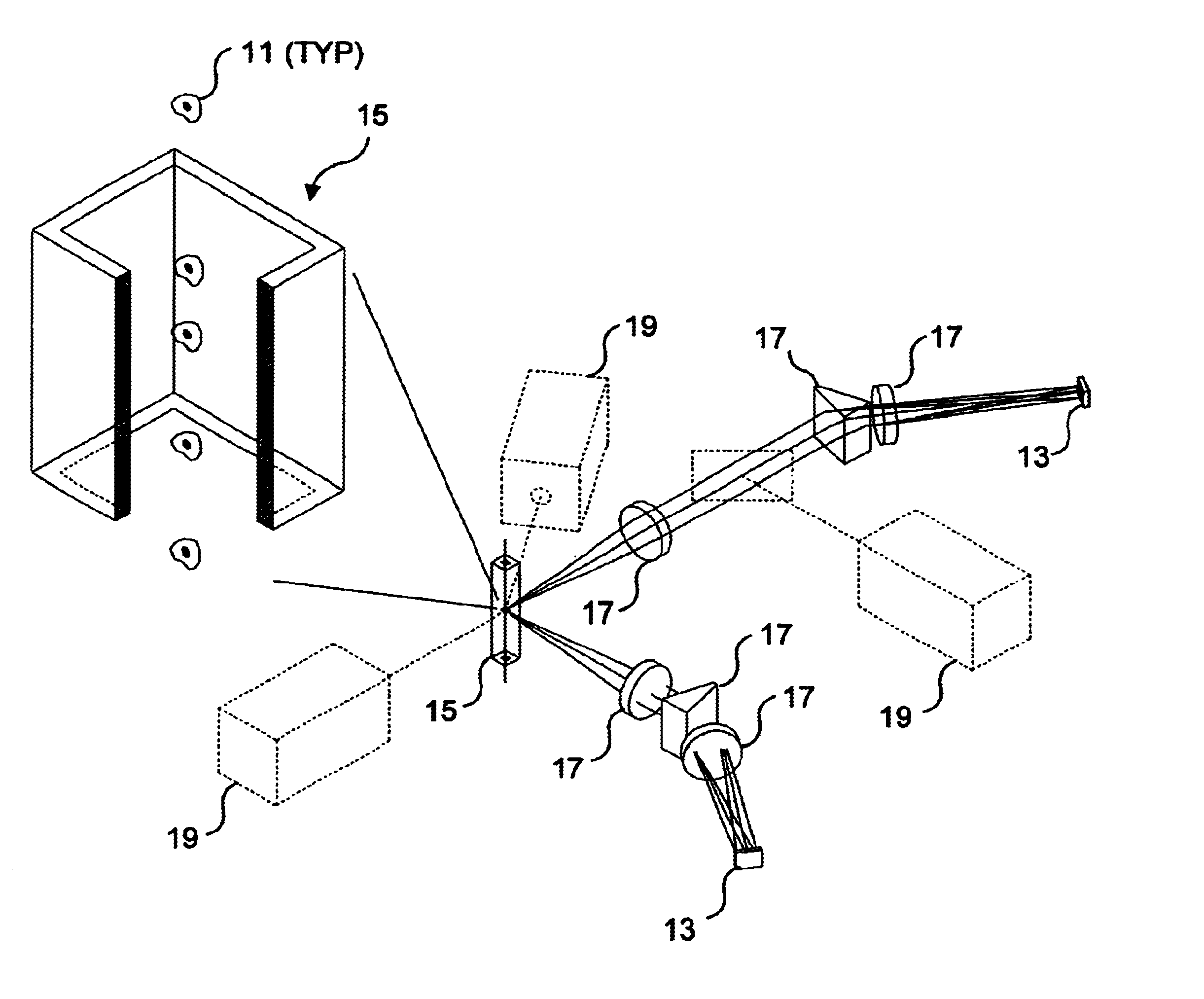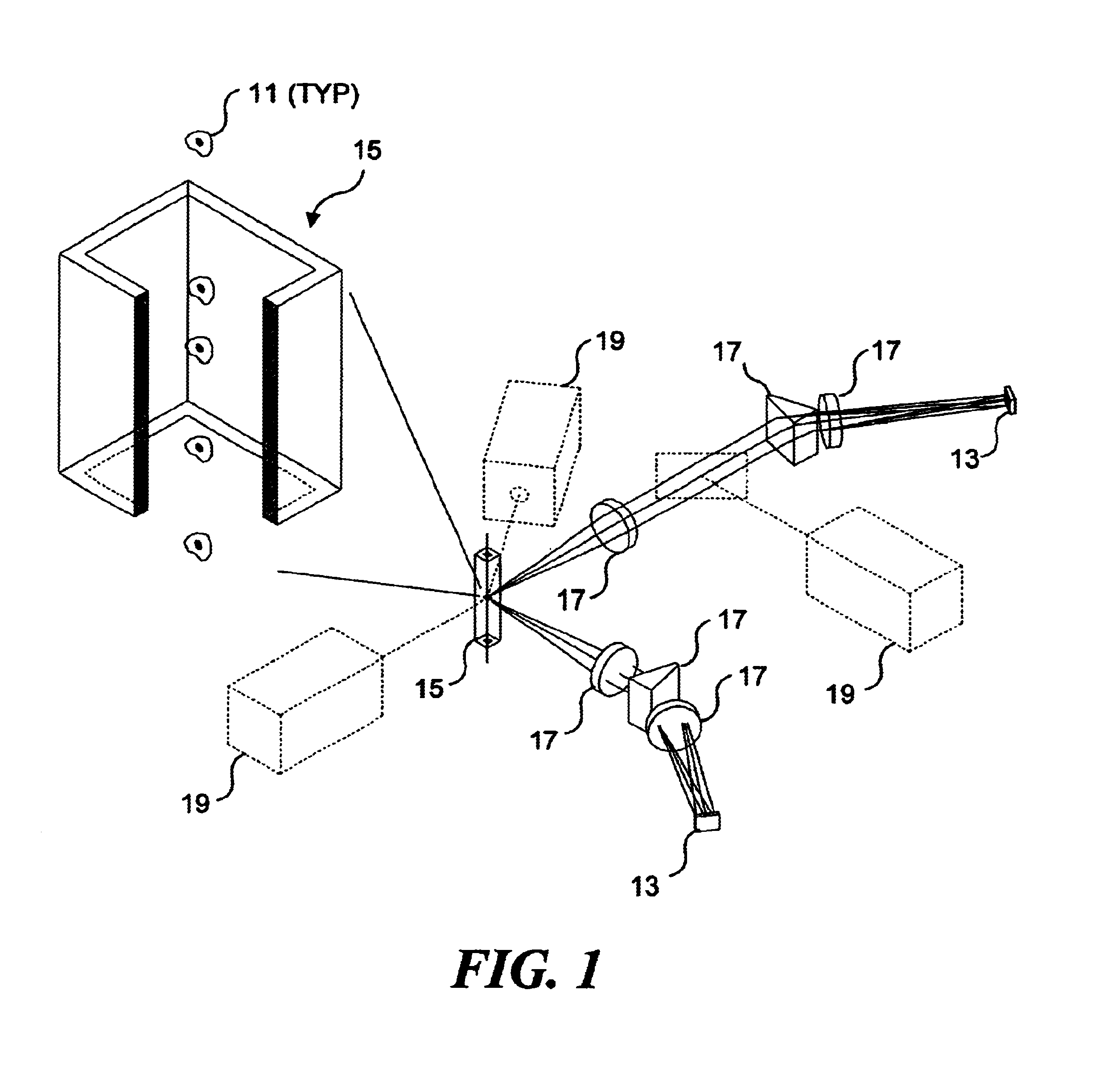Method and apparatus for reading reporter labeled beads
- Summary
- Abstract
- Description
- Claims
- Application Information
AI Technical Summary
Benefits of technology
Problems solved by technology
Method used
Image
Examples
first embodiment
for Spectral Decomposition and Imaging
[0071]A first embodiment of the system for spectral decomposition and imaging is shown in FIG. 2A, and this embodiment is also disclosed in commonly assigned U.S. Pat. No. 6,211,955, entitled “Imaging and Analyzing Parameters of Small Moving Objects Such as Cells,” filed on Mar. 29, 2000, the drawings and disclosure of which are hereby specifically incorporated herein by reference. In this previously filed application, there is no discussion of identifying reporters on beads. However, the following discussion describes how the apparatus disclosed in this previously filed application can be employed for spectral decomposition and imaging of objects such as beads and reporters included thereon. In regard to the present invention, a bead provided with reporters is simply a specific type of object. (It should be noted that where there is any variance between the description in any document incorporated herein by reference and the present disclosure,...
second and third embodiments
of Apparatus for Spectral Decomposition and Imaging
[0099]In the second embodiment of apparatus usable in practicing the present invention, a spectral dispersing component having characteristics that ensure no distortion or convolution of the image occurs due to the emission bandwidth is employed, and as a result, a deconvolution step is not needed to process the image data. FIG. 11 illustrates this second preferred embodiment. Unlike a prism, where every wavelength leaves the prism at a different angle, all light within a predefined bandwidth incident on the dichroic beam splitter at a common angle leaves the dichroic beam splitter at the same angle. Consequently, there is no convolution between the emission spectrum of the light leaving the bead and the image of that bead. When using such a spectral dispersing component, light of a first spectral bandwidth is reflected from the first dichroic beam splitter at a predefined nominal angle. Light of a second spectral bandwidth is passe...
fourth embodiment
of Apparatus for Spectral Decomposition and Imaging
[0110]The fourth embodiment of apparatus usable for spectral decomposition and imaging in connection with the present invention, which is illustrated in FIG. 16A, is similar to the second and third embodiments in that no convolution of the emission spectra with the image occurs as a result of the spectral decomposition process. Spectral decomposition occurs in an axis generally perpendicular to flow through the use of dichroic filters as previously described. However, in this embodiment, separate imaging lenses and detectors are used for each spectral region. Dichroic filters 277 are placed at infinity (with respect to the object) after a collection lens 278 to minimize optical aberrations. After each dichroic filter 276a separate imaging lens 280 is used to form an image of the objects onto the corresponding detectors 282. In this configuration, each detector 282 has fewer pixels than other embodiments because each detector covers ...
PUM
| Property | Measurement | Unit |
|---|---|---|
| Length | aaaaa | aaaaa |
| Flow rate | aaaaa | aaaaa |
| Color | aaaaa | aaaaa |
Abstract
Description
Claims
Application Information
 Login to View More
Login to View More - R&D
- Intellectual Property
- Life Sciences
- Materials
- Tech Scout
- Unparalleled Data Quality
- Higher Quality Content
- 60% Fewer Hallucinations
Browse by: Latest US Patents, China's latest patents, Technical Efficacy Thesaurus, Application Domain, Technology Topic, Popular Technical Reports.
© 2025 PatSnap. All rights reserved.Legal|Privacy policy|Modern Slavery Act Transparency Statement|Sitemap|About US| Contact US: help@patsnap.com



